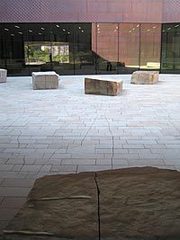 This morning’s Guardian hailed the fresh brilliance of the new Unilever Turbine Hall project at Tate Modern by Doris Salcedo.
This morning’s Guardian hailed the fresh brilliance of the new Unilever Turbine Hall project at Tate Modern by Doris Salcedo.
It shows: “a laudable unwillingness to compromise, wanting to make a work about absolute indifference, and to address desolation and destitution…Shibboleth begins with a hairline crack in the concrete floor by the entrance. As insignificant as a flaw in a teacup, as telling as the build-up scenes of a disaster movie, the crack soon widens and deepens, a jagged crevasse making its jagged way the length of the Turbine Hall, 167 metres away, jabbing a fork of lightning and deepening as it goes. You can never quite see the bottom of it.”
The double page picture spread in this morning’s Guardian centrefold does give a good impression of just how massive this new work of art is, and how astonishing the feat of engineering.
But is Shibboleth really as, er, groundbreaking as it appears?
I haven’t seen the “piece” or the “installation” or whatever it is called, but I have been to the De

Get Britain's best politics newsletters
Register to get The Spectator's insight and opinion straight to your inbox. You can then read two free articles each week.
Already a subscriber? Log in







Comments
Join the debate for just $5 for 3 months
Be part of the conversation with other Spectator readers by getting your first three months for $5.
UNLOCK ACCESS Just $5 for 3 monthsAlready a subscriber? Log in